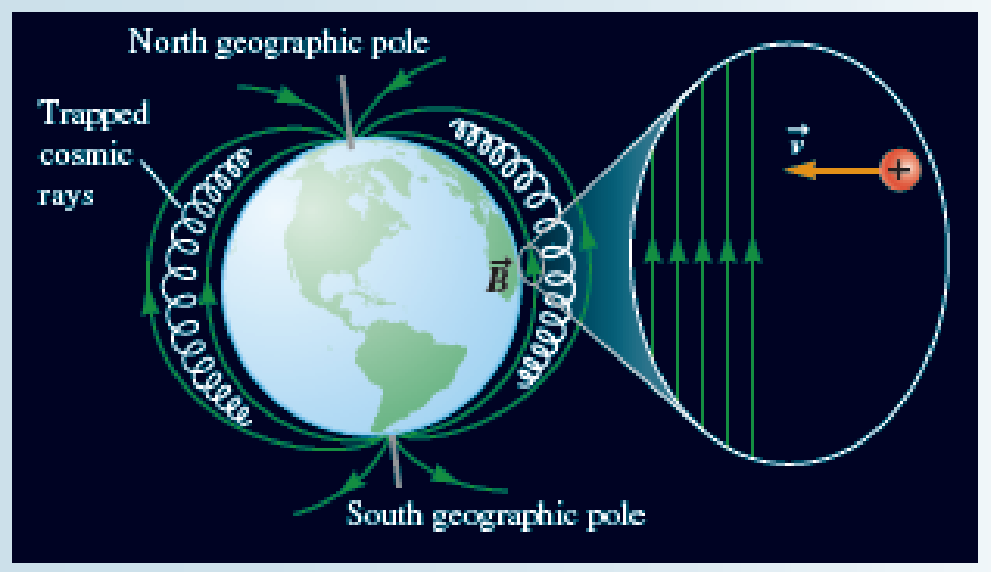
Concept explainers
Cosmic rays are high-energy charged particles produced by astronomical objects. Many of the cosmic rays that make their way to the Earth are trapped by the Earth’s magnetic field and never reach the surface. These trapped cosmic rays are found in the Van Allen belts—donut-shaped zones over the Earth’s equator (Fig. 30.34). These cosmic rays are mostly protons with energies of about 30 MeV. The inset in the figure shows a cosmic ray proton as it is about to enter the Earth’s magnetic field. The cosmic ray’s velocity is initially perpendicular to the field. Three students discuss what happens to the incoming cosmic ray. Decide which student or students are correct.

Figure 30.34 The Van Allen belts are donut-shaped zones of trapped cosmic rays above the Earth’s surface. Inset: What happens to this cosmic ray as it enters the Earth’s magnetic field?
Shannon: The velocity is perpendicular to the magnetic field, so the cosmic ray just passes through the field and hits the Earth’s atmosphere.
Avi: What you are saying is that the magnetic field exerts no force on the cosmic ray. Actually, it exerts a huge force because the velocity is perpendicular to the magnetic field. The force will be into the page.
Cameron: Avi is right. The cosmic ray proton is going to feel a huge magnetic force. Because it is positively charged, it will be pushed upward along the magnetic field lines.
Shannon: I never said the force was zero. There is a force, but the force is perpendicular to the magnetic field lines. In this case, that’s to the left—toward the Earth.
Avi: The force is perpendicular to the magnetic field, but it also has to be perpendicular to the velocity. Because
Want to see the full answer?
Check out a sample textbook solution
Chapter 30 Solutions
EBK WEBASSIGN FOR KATZ'S PHYSICS FOR SC
- Help me make a visualize experimental setup using a word document. For the theory below.arrow_forwardHow to solve this, given answerarrow_forwardThree point-like charges are placed at the corners of a square as shown in the figure, 28.0 cm on each side. Find the minimum amount of work required by an external force to move the charge q1 to infinity. Let q1=-2.10 μC, q2=+2.40 μС, q3=+3.60 μC.arrow_forward
- A point charge of -4.00 nC is at the origin, and a second point charge of 6.00 nC is on the x axis at x= 0.820 mm . Find the magnitude and direction of the electric field at each of the following points on the x axis. x2 = 19.0 cmarrow_forwardFour point-like charges are placed as shown in the figure, three of them are at the corners and one at the center of a square, 36.0 cm on each side. What is the electric potential at the empty corner? Let q1=q3=+26.0 µС, q2=-28.0 μC, and q4=-48.0μc Varrow_forwardPLS HELparrow_forward

 Physics for Scientists and Engineers: Foundations...PhysicsISBN:9781133939146Author:Katz, Debora M.Publisher:Cengage Learning
Physics for Scientists and Engineers: Foundations...PhysicsISBN:9781133939146Author:Katz, Debora M.Publisher:Cengage Learning Principles of Physics: A Calculus-Based TextPhysicsISBN:9781133104261Author:Raymond A. Serway, John W. JewettPublisher:Cengage Learning
Principles of Physics: A Calculus-Based TextPhysicsISBN:9781133104261Author:Raymond A. Serway, John W. JewettPublisher:Cengage Learning Physics for Scientists and Engineers with Modern ...PhysicsISBN:9781337553292Author:Raymond A. Serway, John W. JewettPublisher:Cengage Learning
Physics for Scientists and Engineers with Modern ...PhysicsISBN:9781337553292Author:Raymond A. Serway, John W. JewettPublisher:Cengage Learning Physics for Scientists and EngineersPhysicsISBN:9781337553278Author:Raymond A. Serway, John W. JewettPublisher:Cengage Learning
Physics for Scientists and EngineersPhysicsISBN:9781337553278Author:Raymond A. Serway, John W. JewettPublisher:Cengage Learning Modern PhysicsPhysicsISBN:9781111794378Author:Raymond A. Serway, Clement J. Moses, Curt A. MoyerPublisher:Cengage Learning
Modern PhysicsPhysicsISBN:9781111794378Author:Raymond A. Serway, Clement J. Moses, Curt A. MoyerPublisher:Cengage Learning





